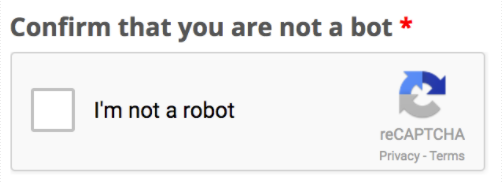Combating Web Form Spam
So you’ve got your new website and it’s everything you wanted it to be. Except now, you have a new problem, your awesome new website seems to have attracted the worst of visitors: spam bots. Your lead generating forms are now cluttering your inbox with messages about a range of unrelated topics. With our recent website redesign we experienced this problem first hand, and boy was it frustrating! Spammers are known to troll fresh sites in an effort to publish their content on your website. You’re probably familiar with email spam, although it’s hardly a problem anymore with how intelligent email providers have gotten at sorting out spam, but web form spam is a different problem altogether. Web form spam results in a large volume of unwanted form submissions containing “junk” text and often irrelevant web links.
So, why do they do it? These spammers have two goals in mind. First, they are looking for vulnerable points of entrance on your website that will allow them to hijack it in order to relay their spam messages via email. Secondly, they are looking to publish their content on your website through comments, guestbooks, etc. If their content does get published with their hyperlinks, it could still lead to a temporary SEO boost for the spammer or the spammer’s clients- of course until Google’s algorithm figures it out.
What can you do to conquer it? There are a few different things you can do to ward off this annoying problem. Note that you do need an experienced web developer to implement these solutions. If you’re a dealer of ours, you can be comforted to know we have a large, growing staff of developers on our team to make sure kinks like this get worked out.
Solutions include:
- Honeypot: This popular method of fighting web form spam consists of entering a hidden form field into the back end of your website that acts as a decoy. Human users cannot see the field but spam bots will. Therefore, when spammers are filling out the forms they’ll automatically fill out this hidden form field and be sorted as spam. For a more thorough explanation of this method, check out this article.
- Random Questions: Another popular method for fighting spam bots is to include a random question in your form that would be hard for bots to answer- for example, questions that require human understanding like, “which is bigger, an elephant or a mouse?” These questions should rotate for the form to be most effective.
- (re)Captcha: This method of tackling web spam used to be a frustrating process as you probably recognize in the image below.
However, Google now offers a free no captcha recaptcha solution that works quite well and in most cases has a minimal impact on UX. Simply check the box that reads “I’m not a robot” and you’re all set!
While this problem is definitely obnoxious and can be discouraging after the exciting accomplishment of launching your new website, it is crucial that you solve it by turning to a developer to implement one of these solutions. By doing so you can better protect your website from being vulnerable to spam, and more quickly respond to genuine leads without having to clean out all the junk. For help with this, feel free to email us at marketing@commercialwebservices.com.




